In a cuckoo Marans versus barred rock chicken fight, which bird is at the top of the pecking order?
Chickens today have ancestors from the Red Jungle fowl of East Asia. Through generations of genetic selection, new breeds have emerged. The cuckoo Marans and barred Rock chicken are two breeds popular for their egg-laying skills. The barred rock chicken can lay 280 brown eggs every year, and the cuckoo Marans lays 200 dark brown eggs.
Cuckoo Marans is a hearty breed that does well in various climates. These active foragers always look for food by scratching and digging in the ground. This breed was named after the French town of Marans, where they first developed in the mid-1800s.
Barred rock chickens have a reputation for being friendly. The black and white stripes on their feathers give them their barred appearance. This breed is known for its curious nature and big appetite.
If a cuckoo Marans and barred rock chicken established a pa pecking order, which breed would be the dominant bird? Read on to find out.
Distinct Characteristics of Cuckoo Marans and Barred Rock Chickens
Chickens are a lot like people. They have distinct personalities and different ways of communicating with each other. To get the full picture for this cuckoo Marans versus barred rock match-up, let’s look at how each bird’s temperament will come into play.
Breed Personalities
The barred chicken is known for having a sweet-natured, gentle temperament. This breed was developed in the middle of the 19th century and was first exhibited in 1869. They’re one of the most docile egg layers around. Owners even describe the roosters as loving and calm.
In contrast, the cuckoo Marans has a reputation for being a bit cuckoo sometimes. This breed can be vocal, flighty, and playful. This chicken likes to be on the move.
Even though the cuckoo Marans is more active than the barred rock chicken, it’s still a fairly mellow bird. The cuckoo Marans is also friendly and does well with other birds. They enjoy foraging, and the hens make good mothers.
What Does a Curious Chicken Look Like?
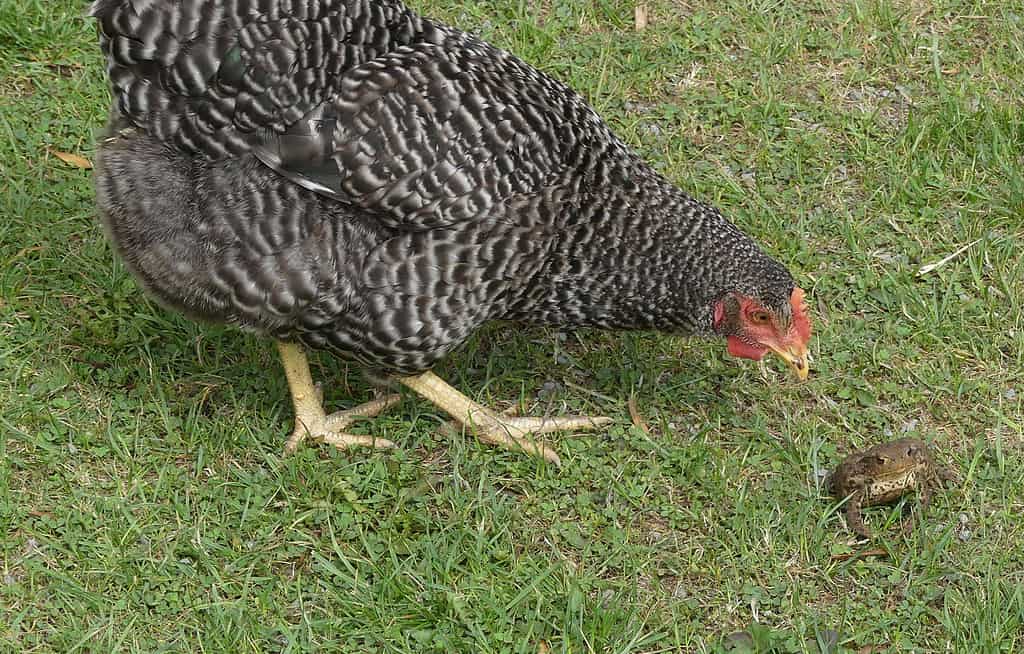
By their very nature, chickens are curious creatures.
©Stephen William Robinson/Shutterstock.com
How can you tell if a chicken is in fight mode versus just being curious? Chickens are curious creatures that love exploring the environment around them. When a chicken is fully engrossed and exploring, the outside world ceases to exist. They become fixated on whatever they’re looking at, giving it their full attention.
When something intrigues them, chickens tilt their heads to the side and lean forward for a better look. Sometimes they also stretch their necks and use their beaks to poke and prod at the object of their curiosity.
Sometimes, chickens are afraid of new objects. They may behave cautiously at first and keep their distance. But as they become more comfortable and brave, they’ll begin to approach the object and eventually explore it with their beak.
There are also cases where a chicken’s curiosity can get them into trouble. Sometimes they swallow the object they’re exploring with their beaks. Pieces of garbage, coins, cigarette butts; there are a lot of things that can grab a chicken’s interest. Sometimes these objects pass through their system without causing any harm. Other times, they cause minor irritation. And in severe cases, swallowing foreign objects can cause internal tears and infections.
What Does an Angry Chicken Look Like?
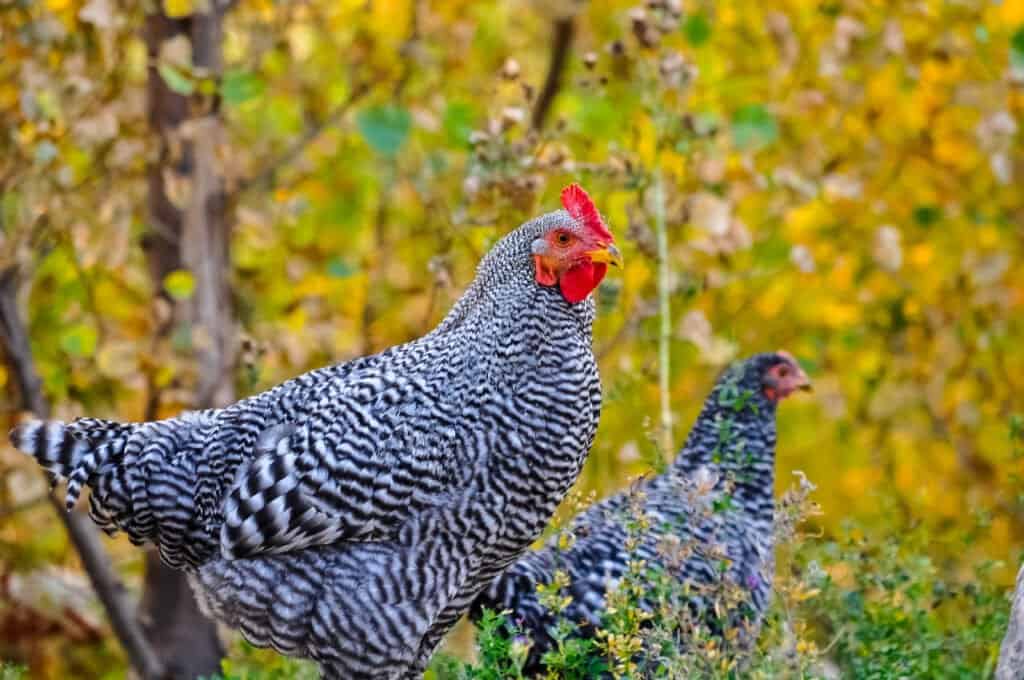
If a chicken pecks or scratches the ground, it’s likely angry.
©Jennifer de Graaf/Shutterstock.com
Squaking, flapping, stomping, pecking! You’ll know when things start to heat up in this cuckoo Marans versus barred rock chicken showdown. It’s easy to spot an angry chicken.
An angry chicken will puff up its feathers, making itself big and intimidating. Sometimes they drop their wings slightly, extending their head and neck forward in a fighting posture. The angry chicken might also aggressively cluck and squawk as they take short quick steps around the area.
Pecking and scratching at the ground are also signs of an aggressive chicken. Unlike a curious chicken exploring the ground, an angry chicken will look like they’re attacking the ground. If they’re really mad, they might peck or bite other animals to assert dominance.
Are the wings flapping? That’s another sign that the chicken might feel threatened. Chickens will flap their wings to scare intruders away.
Finally, look at the chicken’s eyes. Are they bright and alert? Chickens usually have an alert look on their face, but angry chickens go the extra mile. Their eyes can be extra bright, and they’ll maintain fierce eye contact with whoever’s threatening them.
How Cuckoo Marans and Barred Rock Chickens Measure Up
Which breed has more energy for an animal matchup? A chicken breed’s stamina depends on different factors such as age, health, and personality.
Certain breeds are known to be active and energetic, but stamina can vary from one bird to the next. Just because the breed is known for being playful doesn’t mean a chicken falling within that breed will automatically be playful. Instead, every chicken is unique.
Appearance
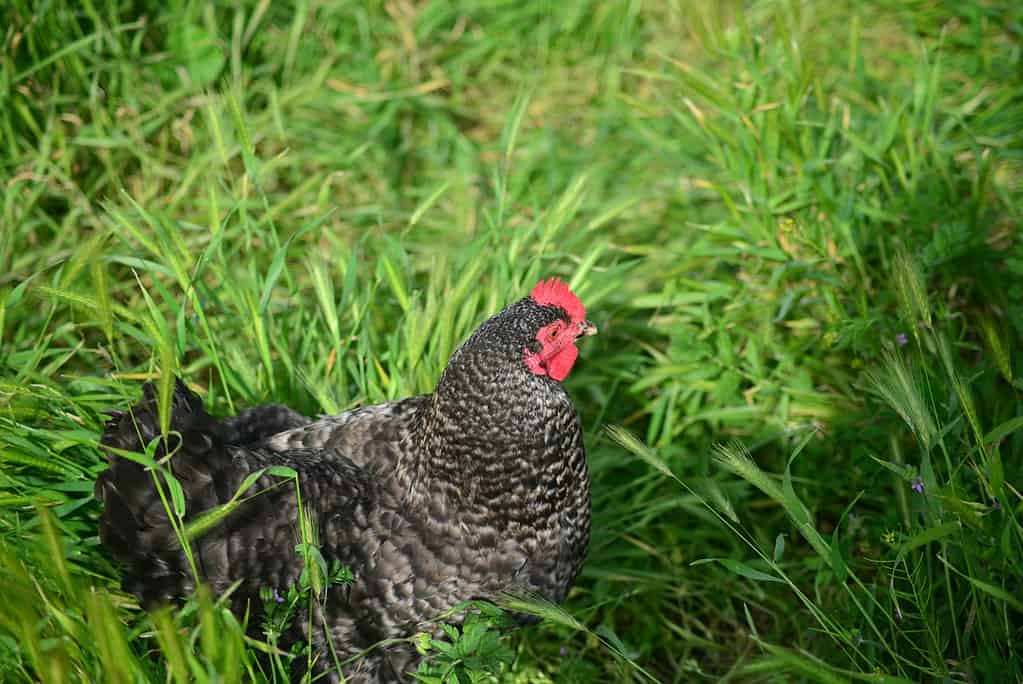
Both cuckoo Marans and barred rock chickens have red combs and wattles. Pictured is a cuckoo Marans.
©ItsAngela/Shutterstock.com
Cuckoo Marans and barred rock chickens are popular breeds of domesticated chickens. They’re known for their distinct physical characteristics. For instance, the cuckoo Marans has dark feathers and white speckles. Alternatively, the barred rock chicken has black and white striped feathers.
Both breeds have red combs and wattles. The comb is the fleshy part on the top of their head, and the wattle dangles underneath their chin. Both males and females have wattles, but their comb becomes brighter and more pronounced as the cockerels mature.
The wattles don’t just look cool; they also help these birds cool down. Birds aren’t capable of sweating, making regulating body temperature difficult. Roosters use their comb and wattles to regulate body temperature. When the summer weather rolls around, and things start heating up, the wattle helps them release excess heat.
Size
Which bird is bigger? Both chickens have comparable sizes. The average weight of a cuckoo Marans is around 6 to 7 pounds, and the average weight of a barred rock chicken is 7 to 8 pounds.
Temperament
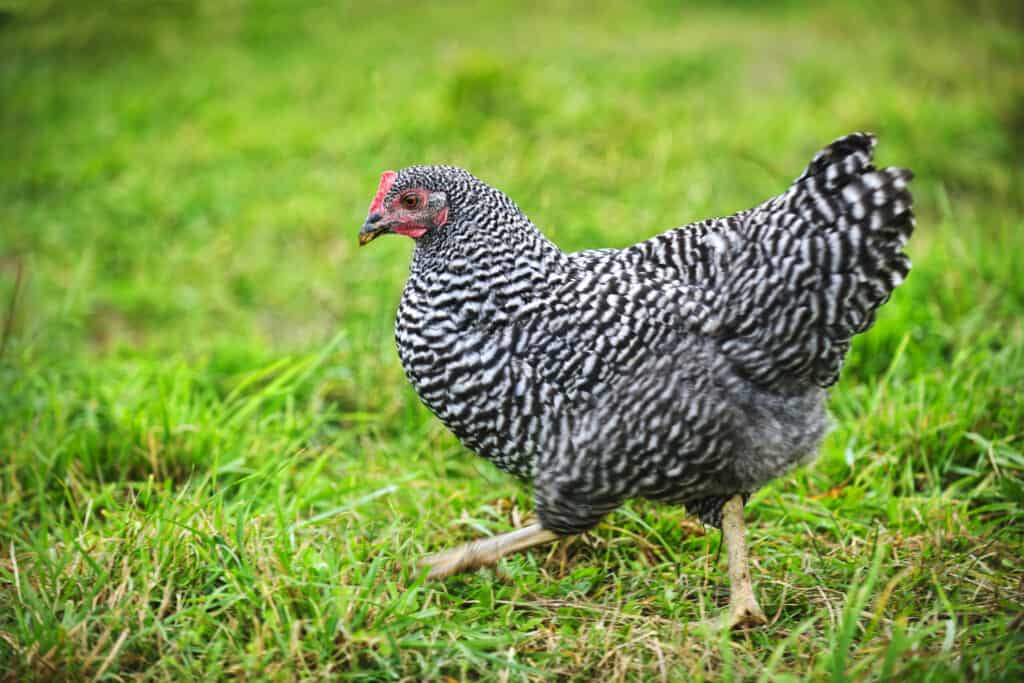
While both cuckoo Marans and barred rock chickens are generally docile, individual birds might act differently. Pictured is a barred rock chicken.
©iStock.com/Elenathewise
What are the chances of a cuckoo Marans versus barred rock chicken fighting? Chickens fight a lot to establish a pecking order, but neither of these breeds has a reputation for being particularly aggressive.
Both breeds are generally docile and easy to care for farm birds. Each individual bird, though, will have different behaviors based on their environment, personality, and health.
Sometimes, cuckoo Marans are more playful than barred rock chickens. Other times they’re laid back. And barred rock chickens are known for their love of foraging and exploring.
Fluffballs: Cuckoo Marans vs. Barred Rock Chicks
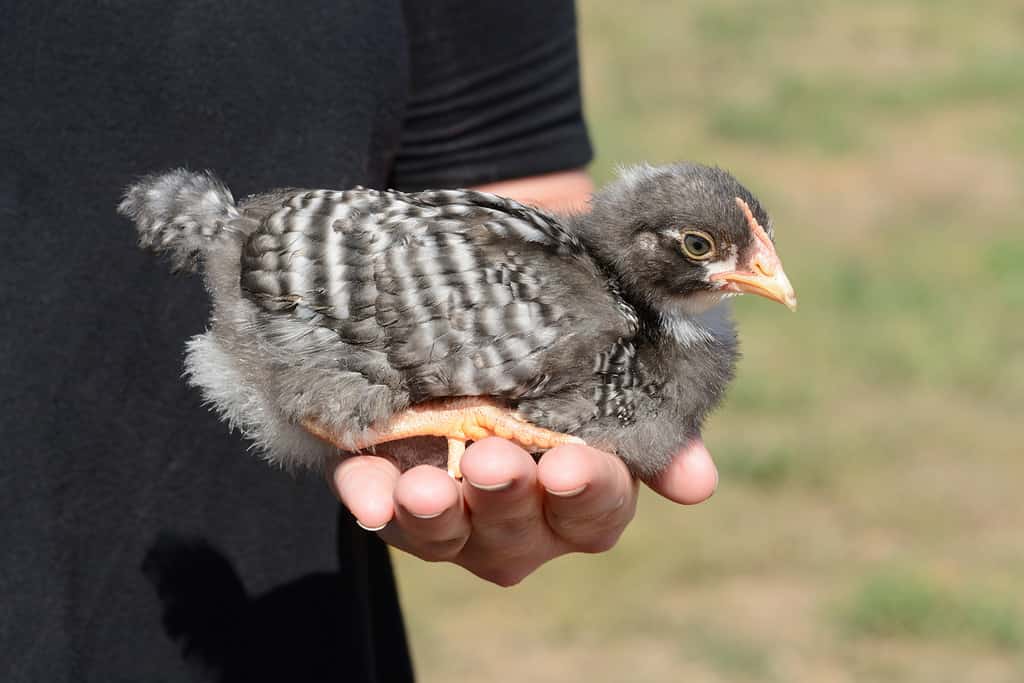
Both baby cuckoo Marans and barred rocks have fluffy down feathers. Pictured is a young barred rock chick.
©Merrimon Crawford/Shutterstock.com
What do cuckoo Marans and barred rock chicks look like? These adorable baby birds have soft, downy feathers.
Baby cuckoo Marans have fluffy down feathers that are light brown or tan in color. In contrast, barred rock chicks have down feathers with black and white stripes.
As chicks, both breeds have cute fluffy bodies and itty bitty beaks. They use these tiny beaks to peck at everything in sight. Cuckoo Marans and barred rock chickens are very active and curious when young. They also have a cute squeaky chirp that helps them communicate with their mother hen and other chicks.
As chicks, cuckoos are known for their resilience. They’re quickly able to adapt to new environments. This makes them a great choice for backyard flocks. And barred rock chickens are known for their social tendencies. These chicks love snuggling up with their siblings for warmth and comfort.
Comparing Legs and Feathers
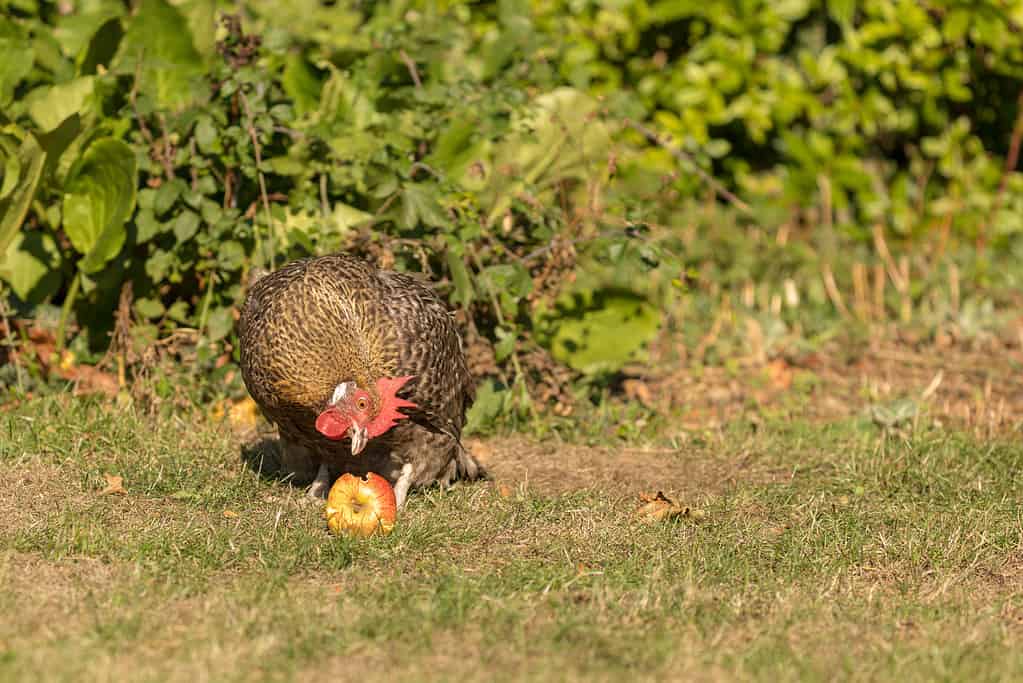
The legs on a cuckoo Marans are long and strong.
©LMIMAGES/Shutterstock.com
Cuckoo Marans chickens have long, strong legs. These resilient limbs help them forage and cover all sorts of rough terrain. Covering their legs, you’ll find feathers down to the feet. These excess feathers help protect against cold weather.
Barred rock chickens don’t have feathers down to the feet, and their legs aren’t as long. They use their legs for scratching and digging when foraging too. Barred rock chickens have a big appetite. They can eat as much as 1.5 pounds of feed per week.
Finally, both breeds have four toes on each foot. Three of the toes are pointing forward, and one points backward.
Now let’s see how both of these breeds move! In the animal kingdom, how a species moves plays a large role in how it hunts and lives. It also can be a determining factor when deciding who has the advantage during a fight.
Cuckoo Marans: Peppy Strut

The movement of a cuckoo Marans is deliberate and almost regal.
©Andy Crocker/Shutterstock.com
Different breeds have different movement strategies. Regarding a cuckoo Marans versus barred rock chicken fight, both breeds can move quickly to catch prey or evade predators. But the way they move is slightly different.
The cuckoo Marans likes to move in a deliberate, regal manner. They look like royalty as they stride through the pen, scratching and pecking. But, when they’re hungry, this breed will pick up the pace.
Since cuckoo Marans are active foragers, they can move around quickly. Their small muscular bodies help them move with agility and speed. Owners describe cuckoo Marans as having a peppy strut. If something startles or frightens them, they can flee or fly safely.
Barred Rock: Confident Stepper
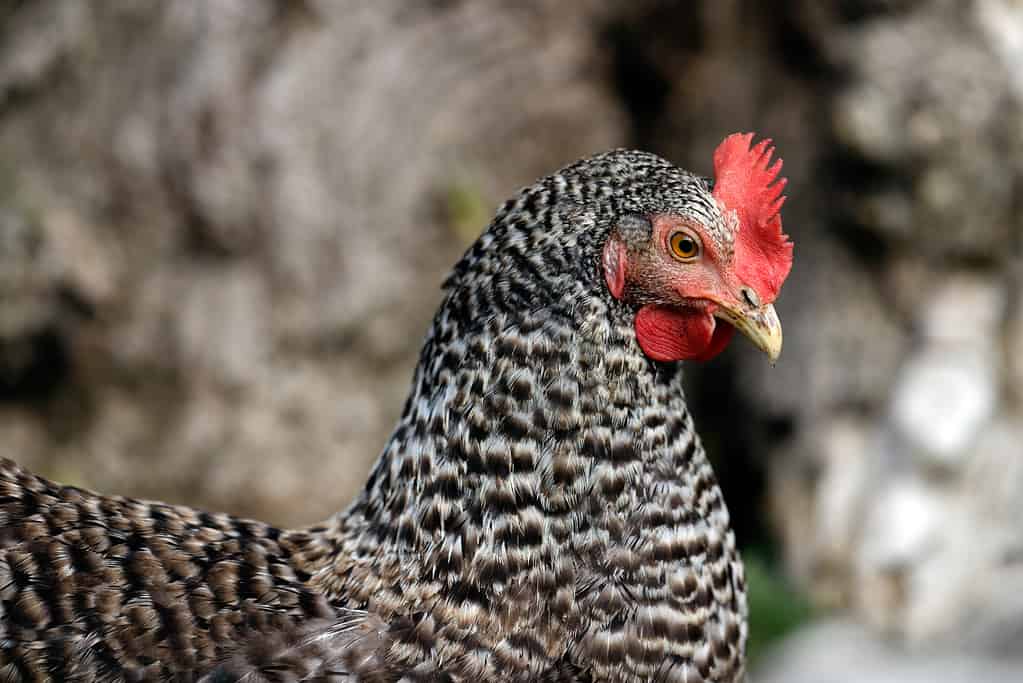
With the confidence they exude, few would want to mess with a barred rock chicken.
©Veroja/Shutterstock.com
Barred rock chickens are small feathered athletes. They exude strength and confidence in every stride. This breed is known for having an assertive gate and purposeful movements.
While exploring their environment, barred rock chickens will hold their heads up high to see everything happening. They also slightly puff up and lift their wings. This high posture gives them a confident appearance.
A barred rock chicken stretches its legs to cover as much ground as possible when they’re running around. They usually have a determined look on their face, with their eyes fixed on the direction they’re headed.
Pecking Order: Why Chickens Fight

Chickens fight to establish a pecking order, which determines who stands where when the birds share space.
©Rob Palmer Photography/Shutterstock.com
Would a cuckoo Marans versus barred rock chicken showdown happen in real life? It could. Both breeds are known for getting along with other animals. However, it’s in a chicken’s nature to argue with other members of its species. It’s how they establish their social hierarchy or pecking order.
In 1921, a Norwegian zoologist named Thorleif Schjelderupb Ebbe coined the term pecking order. This phrase describes how chickens establish a social hierarchy. And it’s not just as simple as choosing who the leader will be.
In a cuckoo Marans versus barred rock chicken fight, they’ll be looking to figure out where they stand throughout the entire group. The pecking order is complex and involves three distinct categories.
Here are the three chicken hierarchies in action:
- Hens to hens
- Rooster to rooster
- Rooster to hens
Each chicken knows their place in the group. For instance, the head hen is the dominant hen in the flock. She’s responsible for finding food and maintaining order.
If, for any reason, roles get confused, a fight can erupt. Fighting happens when the chickens must reestablish their place in the pecking order. Fights can also take place when a new chicken is introduced into the group, and they need to figure out where they fit in.
Reasons to Fight
Establishing the pecking order isn’t the only reason chickens fight. Sometimes they get into arguments over food, water, or space. And certain breeds are more prone to aggressive behavior than others.
Since chickens are curious creatures, boredom can lead to fighting. If they’re restless and don’t have a way to burn off their energy, they’re more likely to have disputes. Fear and stress can also trigger arguments.
Chickens need adequate space, food, water, and socialization. When they have all of these things, that helps prevent and minimize fighting. The birds won’t feel like they have to compete for nesting spots or other resources and can comfortably get along within the pecking order.
Can Cuckoo Marans and Barred Rocks Get Along?
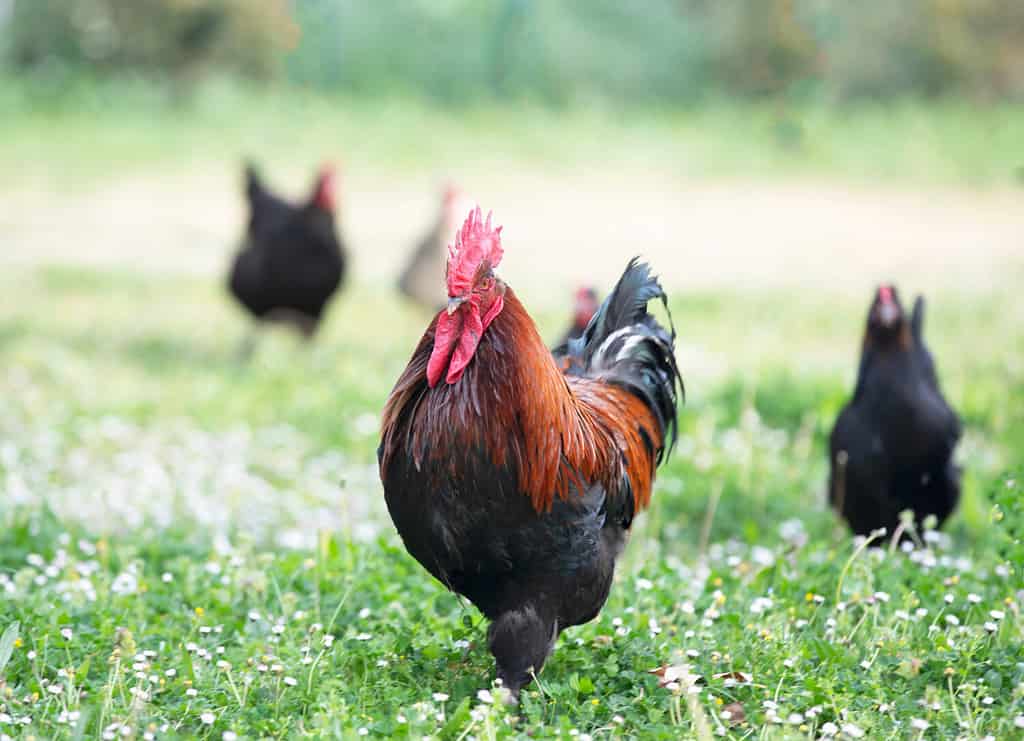
Generally speaking, chickens can get along with each other so long as their environment is favorable to them.
©cynoclub/Shutterstock.com
Cuckoo and barred rock chickens can get along. These breeds can coexist as long as they have favorable living conditions.
When it comes to cuckoo Marans versus barred rock chickens, chicken keepers enjoy both. Both breeds can peacefully coexist within a flock.
Making Chicken Friends
How do you avoid a cuckoo Marans versus barred rock chicken battle? It starts by introducing them the right way.
First, quarantine new birds. This is a good measure to ensure they’re healthy before introducing the birds to the rest of the flock. Then you can slowly introduce the birds to the flock if they are healthy.
Gradual introductions help with the integration of new members. Some chicken keepers suggest introducing the new birds at night while the existing birds roost. When the flock wakes up in the morning, they can get to know each other.
Things might be rough as they established the new pecking order. But be patient. New members usually take less than a month to fit in fully.
Chickens like being around other chickens. They’re social animals who enjoy interacting with each other. Having multiple breeds and personalities within the same flock can enrich their lives. However, the chickens need enough space to move around and enough food and water to prevent conflicts.
Cuckoo Marans vs. Barred Rock Chicken: Who Is the Winner?

Who wins in a cuckoo Marans versus barred rock chicken showdown? Today’s animal matchup is a tie.
Both breeds have distinct personalities, physical strengths, and peppy energy. They aren’t known for being aggressive and can coexist when introduced properly. Of course, they would want to establish a pecking order if a cuckoo Marans and barred rock chicken were introduced. It’s impossible to say which species would establish itself as the leader, though.
The dominant bird would depend entirely on the individual bird’s personality. Generalizations exist about the personalities of chicken breeds. But any experienced chicken owner will tell you these birds are never the same. Just because one cuckoo Marans was playful and dominant doesn’t mean the next one will be.
Age could be a deciding factor in this animal matchup. When establishing the pecking order, adults are always the boss. An older chicken will peck at chicks to let them know who’s in charge. This can be seen as bullying, but it’s really a good thing. Chickens need to know where they stand within the group to coexist peacefully.
Bonus: Which Chicken Breed is the Most Affectionate?
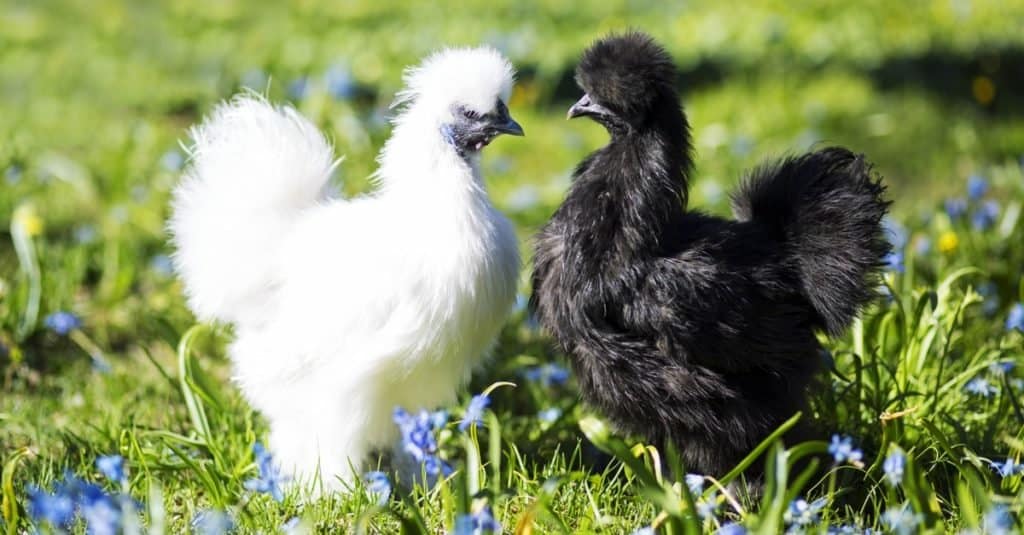
Silkie chickens aren’t the greatest layers – but they have sweet personalities and love being petted.
©Einar Muoni/Shutterstock.com
While both cuckoo Marans and barred rock chickens are friendly and easygoing – the silkie is the breed known for its sweet, affectionate personality. Their soft, fluffy feathers make them even more appealing to pet – and they actually like being petted! Silkies are also among the smartest chicken breeds and can even be trained to walk on a leash.
If you are getting into raising backyard chickens for eggs – a silkie isn’t your bird. They only lay around 100 small, cream-colored eggs a year. They also can’t fly at all – not even to get to a higher spot to avoid threatening animals. A good mix of chickens might include a few silkies as pets – especially if you have children. Your silkies could contribute a few eggs while providing your family with a charming pet!
The photo featured at the top of this post is ©
Thank you for reading! Have some feedback for us? Contact the AZ Animals editorial team.







